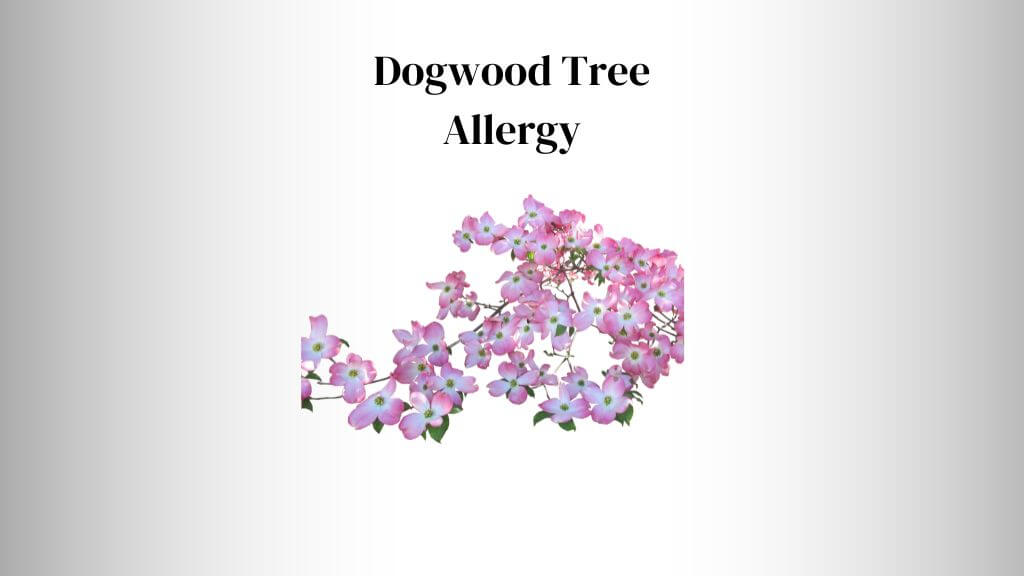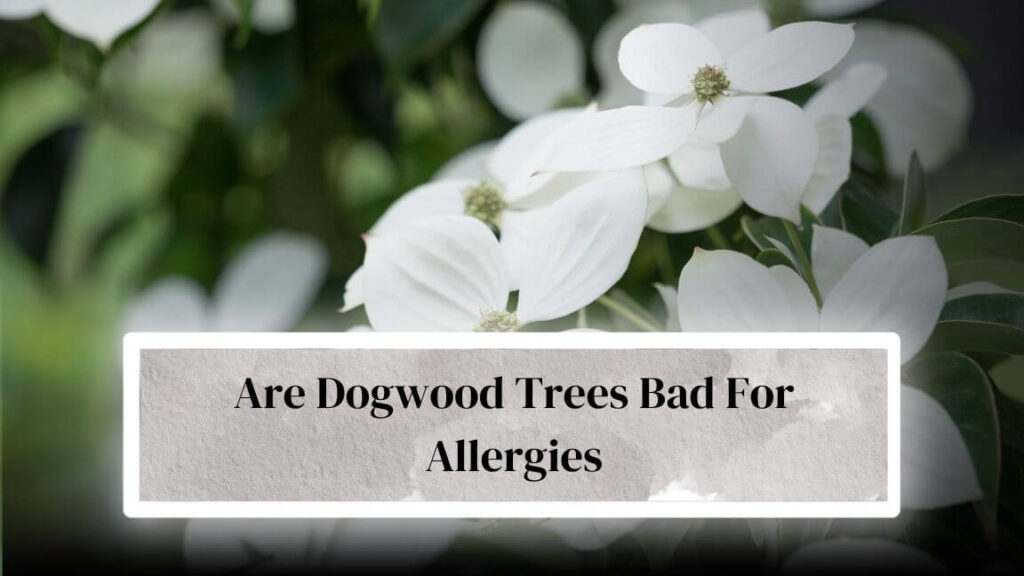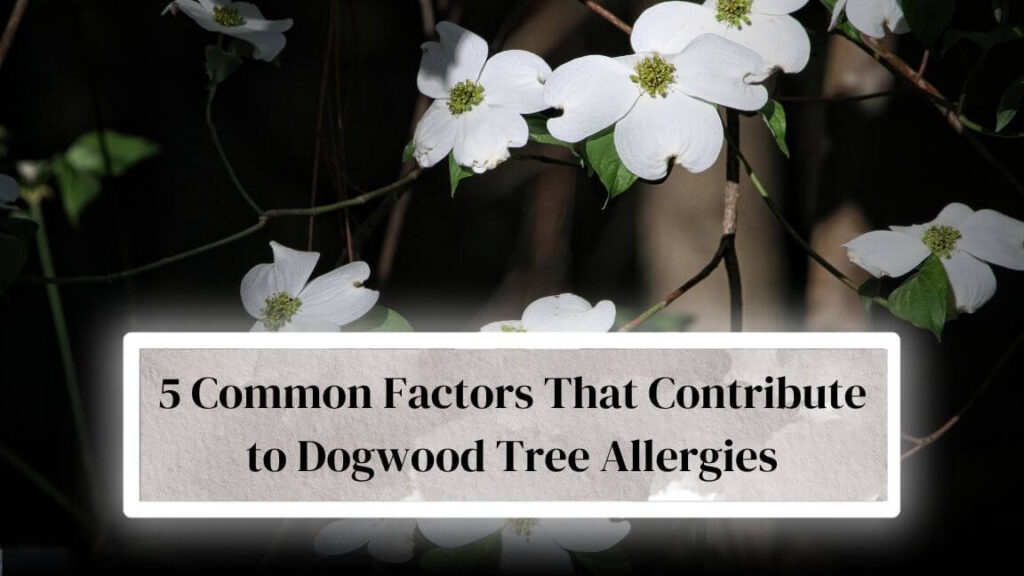
Thousands of people in the United States suffer from allergies due to an over-sensitive immune system. If you want to know ‘Are dogwood trees bad for allergies’ or ‘Do dogwood trees cause allergies, ‘ this article is for you.
If you suffer from an over-sensitive immune system, it may overreact to even normal harness substances like tree pollen, dust, or pet dander. When a person’s immune system overreacts, it usually produces histamines that cause symptoms like sneezing, itching, and a runny nose.
Here we will discuss dogwood tree allergy symptoms, the common factors that can contribute to allergies, dogwood pollen allergy, and dogwood allergy rashes, along with treatment options.
Are Dogwood Trees Bad For Allergies

If you have an oversensitive immune system or are an allergy sufferer, you may experience histamine symptoms around the dogwood trees. While these trees can cause allergic reactions, there are also many benefits to having them in your yard.
Fortunately, dogwood trees are not among the most allergenic trees you’re likely to find in the nursery. Dogwood ranked 23rd out of 46 trees tested for their ability to cause allergic reactions in humans with weak digestive systems/ oversensitive immune systems.
Even though dogwood tree has the potential to cause allergies, they also offer many benefits to homeowners, as they act as a focal point, provide shade, attract wildlife, and improve air quality. They are also a very popular ornamental tree prized for their attractive blooms & colorful fall foliage.
Therefore, if you like to have one in your landscape, you can safely have dogwood trees. Even allergy sufferers can safely plant dogwood trees in their yards because they are not among the most allergenic trees and are generally considered safe for most people.
Do Dogwood Trees Cause Allergies
Yes, dogwood tree pollen can trigger your allergies if you don’t take proper precautions.
Even though dogwood trees are not among the most allergenic trees, people have complained about dogwood allergy rashes due to exposure to Pollen, & other parts of their dogwood tree. Your allergies are more likely to be triggered when you’re in a landscape with lots of trees & plants.
The pollen/allergens can be carried by the wind or insects and then come into contact with your skin or respiratory system. You should know that several factors can indirectly increase the likelihood of developing a dogwood allergy like
:
- If you live in an area with a high concentration of dogwood trees, you’ll likely experience allergy symptoms.
- People with a history of allergies or asthma may suffer from reactions being around a dogwood tree.
- You are being exposed to other allergens like Pollen or mold.
5 Dogwood Tree Allergy Symptoms
If you notice any symptoms while being around dogwood trees, you must seek medical attention from professionals. You should note that the symptoms of a dogwood tree allergy are going to vary from person to person, but the most commons are:
- Sneezing
- Runny nose
- Watery eyes
- Itchy eyes, nose, and throat
- Skin rash or hives
Note: The dogwood tree allergy symptoms can be mild to severe. Also, it can last for several days or weeks.
Physical & Biological Causes of Dogwood Tree Allergy Symptoms
In major cases, people reported Pollen as the major culprit that triggers allergies. The dogwood trees release pollen into the air during the spring & early summer. People often visit parks and landscapes during this time.
If you have an over-sensitive immune system, you should avoid being around trees that may cause allergies. Suppose you have an over-sensitive immune system and come into contact with Pollen.
In that case, your immune system is likely to overreact, causing the symptoms mentioned above associated with allergies. You should know that Pollen tends to be usually small & light, allowing it to easily travel through the air and enter people’s bodies easily.
Below I am giving you some physical causes and biological causes of dogwood tree allergy.
| Physical Causes | Biological Causes |
| Small and light pollen | Overreaction of immune system |
| Travels easily through air | Production of histamines |
| Enters body easily | Inflammatory response |
5 Common Factors That Contribute to Dogwood Tree Allergies

As I told you above, several factors can contribute to developing dogwood tree allergies. These include:
- Genetic predisposition to allergies
- Exposure to other allergens like Pollen or pet dander
- Living in an area with high levels of pollution or Pollen
- Weakened immune system due to illness or stress
- Living in an area with a high concentration of dogwood trees.
Also, Check
Dogwood Pollen Allergies
As I told you repeatedly in this article, dogwood pollen allergies are more common than allergies from mold, bark, leaves, or other body parts. Dogwood pollen allergies are likely to get triggered during the bloom season, typically in the spring and early summer.
If you experience any symptoms like sneezing, runny nose, or itchy eyes, get back to your home or a safe place free from allergens. After that, consider taking antihistamines or the medications your doctor recommends.
How Does Dogwood Pollen Affect Allergy Sufferers?
During the bloom season, a dogwood tree will produce lots of Pollen, which will also get carried out through air or wildlife that can trigger anyone’s allergy.
If you accidentally come into contact with the Pollen, it may trigger your allergies by entering your body because it’s light & small.
People living around landscapes during the spring or summer season often suffer from an overreaction of their immune system due to the production of allergens.
Comparison of Dogwood Pollen Allergies to Other Types of Pollen Allergies
Well, Dogwood pollen allergies are very similar to other pollen allergies like oak or ragweed. However, you’ll not find dogwood pollen as prevalent as other types of Pollen. Thus, it may not affect as many people as we think.
Dogwood Pollen size, production, and seasonal timing determine how much you’re likely to experience the allergy symptoms around it.
Since all Pollen is light & small that can easily enter our bodies and travel through the air, you should wear a mask & proper gear to keep you protected outdoors during summer or spring.
Dogwood Allergy Rash: Why Happens & What To Do
Dogwood allergy rash is nothing more than a type of skin reaction that affects people when they come into direct contact with the Pollen or other parts of the dogwood tree.
You should note that Dogwood allergy rash usually appears red, itchy, & inflamed skin. Other symptoms like sneezing, watery eyes, & nasal congestion can also accompany this.
As per reports and my research, falling is the main cause of dog would cause allergy rashes because they are light and can be carried out by wind or insects to come in contact with your skin or respiratory system.
If you think your dog’s energy has affected you, there are a few things you should be doing to treat it.
The main cause of dogwood allergy rash is exposure to Pollen and other parts of the dogwood tree. These can be carried by the wind or insects and come into contact with a person’s skin or respiratory system.
If you develop a dogwood allergy rash, there are several things you can do to treat it. These include:
- Firstly, apply a cool, damp compress to the affected area.
- In addition, you need to use over-the-counter antihistamines to reduce itching & inflammation and suppress allergy symptoms.
- It would help if you also considered applying topical corticosteroid creams or ointments that can ease up & reduce inflammation & itching.
Pro Tip: If you want to soothe your skin, consider bathing with colloidal oatmeal or baking soda.
Note: If your symptoms are severe or persistent, you must visit a nearby clinic and see a doctor for additional treatment.
Treatment Options for Dogwood Tree Allergies
- If you think your allergies are triggered, you must take over-the-counter antihistamines like loratadine or cetirizine.
- If your information or no swelling is not relieving, you should consider taking nasal corticosteroids.
- Suppose you want dogwood trees in your landscape but can’t because of an over-sensitive immune system. In that case, you can consider Immunotherapy, which involves getting regular injections of allergens to help desensitize the immune system.
- It would help if you avoided visiting areas with a high concentration of dogwood trees or areas with high levels of Pollen.
- Have you ever known that Consuming local honey also helps build immunity to local allergens?
- I’ve seen a few people frequently using a saline nasal rinse to flush out Pollen and other allergens from their nasal passages. If you need, you can also do this.
- Lastly, you’ll need to take supplements that contain essential nutrients like vitamin C, which is known to help reduce inflammation in our body.
You should note that natural remedies are not for everyone, and the degree of sensitivity along with allergic symptoms will vary from person to person. It would help to consider all these treatment options as a helpful addition to traditional treatment methods.
As with any treatment, you must consult your doctor before trying these natural remedies because you want to be on the safe side & ensure effectiveness depending on your personal need. Before you start, talk with the doctor because some may also have side effects or interact with other medications.
5 Tips to Reduce the Likelihood of Dogwood Allergies
- It would help if you considered planting male dogwood trees because they do not produce Pollen.
- It’s best to keep your windows and doors closed during high pollen seasons.
- Almost everyone suffering from over-sensitive immune systems has installed an air filter or purifier. It would help if you also did this to reduce Pollen and other allergens in your home.
- When you are on a walk on working outside during the high pollen season, it’s best to wear a proper face mask, as I told you earlier.
- Even though over-the-counter antihistamines are safe to take directly, it’s still best to consult with your doctor, especially if you take any other medications.
Conclusion
I hope you know everything about Dawood tree or dogwood pollen allergy. You must wear a proper mask when you go outside next time. It is also best to plant a dogwood tree that is male and doesn’t produce Pollen.
Also, it’s best to close your windows and door during the high pollen season because wildlife & air can still carry these light Pollen for miles and trigger your allergies. If you think you are suffering from allergies, taking antihistamines after consulting with your doctor is advised.
Do check our other helpful guide on dogwood tree care that has been shared on this website. If you find this article helpful, then consider sharing it.
Your share will have many people learn about the proper precautions they should take along with the steps they should follow during a dogwood allergy rash. See you in the next post, till then, take care and goodbye.
